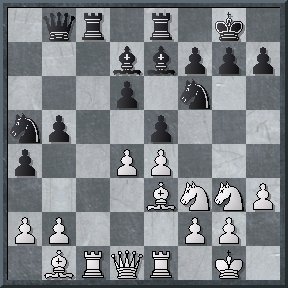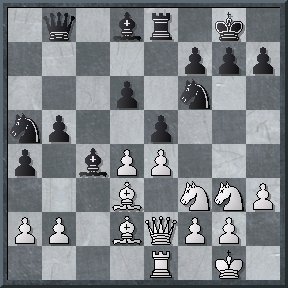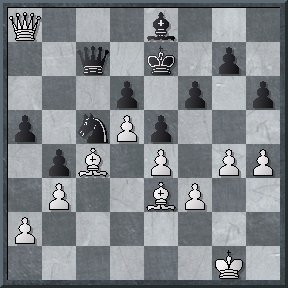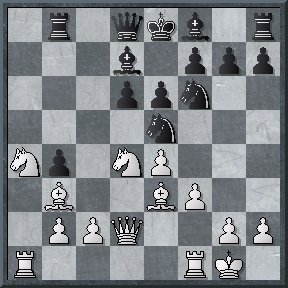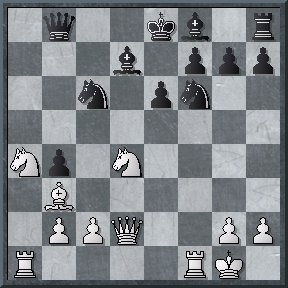08.11.2006
TAL MEMORIAL. GAMES OF ROUND 2 COMMENTED
Round 2 was marked with no less intense fight, and it's quite thrilling to watch superfighters sway under heavy positional blows and yet escape a knockout.
A game between Gelfand and Ponomariov is interesting mostly by Ponomariov's choice of a somewhat dubious and very rare variation once favoured by Romanishin.
Gelfand,B (2733) - Ponomariov,R (2703) [E36]
Tal Memorial Moscow RUS (2), 07.11.2006
1.d4 ¤f6 2.c4 e6 3.¤c3 Ґb4 4.Јc2 d5 5.a3 Ґxc3+ 6.Јxc3 c5 7.dxc5 d4 8.Јg3 [8.Јc2 seems to be more solid] 8...0-0
[The ever-creative author of black's opening idea Oleg Romanishin recommends here 8...¤c6 and after 9.¤f3 (9.Јxg7 ¦g8 10.Јh6 e5 with compensation) black has 9...e5 Black also tried9...0-0 10.Ґh6 ¤e8 11.0-0-0 f6 The game has some ideas in common with the one we analyse. White's active bishop on h6 after 12.e3 becomes just a sacrificed animal. In the game after 12.Ґd2 b6! 13.e3 bxc5 (Khismatullin-Yemelin, Dagomys 2006) black reached a good position.]
9.Ґh6 ¤e8 10.e3 ¤c6 11.0-0-0 Јc7 12.Јxc7 A piece sacrifice12.Ґxg7 Јxg3 13.hxg3 ўxg7 14.exd4 ¤f6 results in an unclear endgame.
12...¤xc7 13.Ґf4 White could try to gain something with 13.Ґg5!? f6 14.Ґh4 dxe3 15.fxe3 a5 16.Ґf2 and then e3-e4 holding c5-pawn
13...e5 14.Ґg3 dxe3 15.fxe3 a5 16.¤e2 ¤e6 Decentalization 16...¤a6!? was a possible way White would probably have to sacrifice an exchange 17.¦d5 Ґe6 18.¤c3!? ¦ac8 19.¤e4 Ґxd5 20.cxd5 and now black can opt for either 20...¤xc5 21.¤xc5 ¤b8 22.b4 axb4 23.axb4 b6 24.Ґxe5 bxc5 25.b5 with compensation or 20...¤cb8 after which white probably has to play on domination being a pure exchange down: 21.c6!?
17.¦d5 [17.¤c3 a4 18.¦d5 f6 led to the same] 17...f6 18.¤c3 a4 19.¤e4 [19.Ґf2 deserved attention followed by ¤b5, e3-e4] 19...¤e7 20.¦d1 ¤c6 21.¦d5 ¤e7 22.¦d1 ¤c6 23.¦d5 1/2-1/2
Svidler,P (2750) - Shirov,A (2720) [C99]
Tal Memorial Moscow RUS (2), 07.11.2006
1.e4 e5 2.¤f3 ¤c6 3.Ґb5 a6 4.Ґa4 ¤f6 5.0-0 Ґe7 6.¦e1 b5 7.Ґb3 d6 8.c3 0-0 9.h3 ¤a5 10.Ґc2 c5 11.d4 Јc7 12.¤bd2 cxd4 13.cxd4 ¤c6 14.¤b3 a5 15.Ґe3 a4 16.¤bd2 Ґd7 17.¦c1 ¦ac8 18.¤f1 Јb8 19.¤g3 ¦fe8 20.Ґb1 ¤a5 ...
I'd prefer another theoretical move 20...Ґd8, the bishop may sometimes jump...(well, I mean "move", I've never seen a jumping bishop) to a5.
21.¦xc8 [21.b3 was previously tried] 21...Ґxc8 [After21...¦xc8 22.Ґg5 white has an unpleasant threat d4xe5]
22.Ґd3 Ґe6 23.Ґd2 Ґd8 Suggesting itself 23...¤c4 may be replied either with a solid 24.Ґc1 planning to chase the knight back with b2-b3 or with 24.Ґc3 In the latter case after24...b4!? 25.d5 bxc3 26.Ґxc4 Ґd7 27.bxc3 Ґd8 28.Јd3 (28.Јe2 Ґa5; 28.Јc2 Јc8 /\Јc5) 28...Ґb6 29.¦b1 Јa7 30.Јc2 a question whether black's strong dark squared bishop compensates minimal material deficiency remains open.
24.Јe2 Ґc4
Perhaps, the critical moment of this seemingly bloodless game. White could keep some pressure by both closing the center with25.d5 ¤d7 26.Ґb4+/= or maintaining the tension with 25.Ґc3 Move 25.¦c1 chosen by Peter allowed black to develop counterplay:
25...exd4! 26.Ґxa5 26.¤xd4 d5 is unpleasant for white.
26...Ґxa5 Black has no reason to take away the tenbsion 26...Ґxd3 27.Јxd3 Ґxa5 28.¤xd4 and white is better.]
27.Ґxc4 bxc4 28.Јxc4 Taking the pawn with the rook gave black good play after28.¦xc4 a3 29.bxa3 d5
28...Јxb2 Now after 29.¤xd4 Ґb6=/+ black gets some pressure thus white rushes to catch the last train to easy life. 29.¦c2 Јb1+ 30.¦c1 Јb2 31.¦c2 Јb1+ 32.¦c1 1/2-1/2
The decisive events of the game Morozevich-Carlsen shoud be traced from the diagram position.
Morozevich,A (2747) - Carlsen,M (2698) [B33]
Tal Memorial Moscow BUS (2), 07.11.2006
In the beginning of the game chose the variation currently considered to be harmless for black in Sveshnikov variation. Magnus didn't know the line and that made him passively defend a worse position through the whole game.
37.g5 hxg5 38.hxg5 Thestructure changes the last time in this game. Aleksandr keeps on looking for a means to break through...
38...ўf7 39.ўg2 ўe7 40.ўg3 ўf7 41.ўg4 ўe7 Black could here devaluate white's triangular manouevre with41...Ґd7+ and insofar as after 42.ўh4 fxg5+ 43.ўxg5 a4 44.ўh5 ¤b7 black has counterplay and white king may be endangered, white would have to return back with the king to g3.
42.ўh4 ўf7 43.ўh3 I think this retreat is reasonable. An attempt to break through with43.g6+ ўe7 44.Ґb5 (after 44.ўh5 black should choose not 44...¤d7 45.Јa7 with a better endgame but 44...a4 White’s active king provides black with a number of tactical motives ) 44...Ґxg6 45.Јg8 Ґf7 46.Јxg7 Јc8 gained nothing. Probably white should try to return the king back and move the bishop towards h4 square.
43...ўe7 44.ўg2 ўf7 45.Ґd2 1/2-1/2
It's rumoured that the game was declared draw by triple repetition of the position on Carlsen demand. It would mean the last move is given on the official site incorrect. Yet even if we suppose something like 45...ўe7 46.Ґe3 actually played (and 46...ўf7 written on the scoresheet) this will not lead to any triple repetition as long as it matters who is currently to move (see move 39, 44 and plausible 46)! It's also rumoured that was exactly the mistake Gijsen made... Well, Zenith's soccer club fans would find good words for referees better than me.
Aronian managed to outplay Mamedyarov with black and reached a queens ending with an extra pawn. A strong passed pawn gave white good drawing chances while black perhaps didn't use all his chances. Yet I consider such an ending too subtle not only for play but even for this express-comment of the round.
Thus we get down to the last game remaining, in which Grischuk with black had a perfect chance to recoup all his moral losses of the first round.
Leko,P (2741) - Grischuk,A (2710) [B90]
Tal Memorial Moscow RUS (2), 07.11.2006
1.e4 c5 2.¤f3 d6 3.d4 cxd4 4.¤xd4 ¤f6 5.¤c3 a6 6.f3 e6 7.Ґe3 b5 8.Јd2 b4 9.¤a4 ¤bd7 10.Ґc4 Leko already tried this move against this fashionable Najdorf line against Gelfand in Dortmund this year. His opponent reacted with10...Јc7 Grischuk meets white's idea fully armed. 10...¤e5 11.Ґb3 ¦b8 12.0-0 Ґd7 13.a3 a5 14.axb4 axb4
If black is allowed to finish development the misplaced knight will make white's position clearly worse. Therefore white launches an assault, which as we shall see fails to solve his main problem anyway.
15.f4 ¤c6 Grabbing a pawn would be completely wrong:15...¤xe4 16.Јe2 ¤c6 17.f5 ¤xd4 18.Ґxd4 d5 19.fxe6 Ґxe6 20.Јe3+/- with a clear advantage; 15...¤eg4 probably forced 16.e5 anyway.
16.e5 dxe5 17.fxe5 ¤xe5 18.Ґf4 ¤c6! Black sacrifices an exchange becauseafter 18...Јc7 19.¦ad1 he would have severe development problems. 19.Ґxb8 Јxb8 Black can be fully content with the opening results. Insofar as white cannot hinder black's finishing development, a strong dark squared bishop gives black more than enough compensation while white is going to suffer because of the knight on a4 almost till the end of the game.
Leko took a decision to simplify to an endgame after 20.¦ad1 Ґe7 21.Јf4 Let us skip 30 moves and get down to a position of black's total domination which Grischuk reached with fine purposeful play.
52...¦e3 h3-pawn is very strong. Even though presence of black rook on the board promises mating threats to white's king, maybe black should have strived to exchange the rooks thus reducing white's counterplay. An alternative to a move in the game could be52...¦e4 53.ўf1 e5 54.¤b6 ¦d4 55.¦xd4 ¤xh2+ 56.ўe2 exd4 57.¦h1 d3+ 58.ўxd3 ¤g4 59.ўe2 h2 In spite of the reduction of the material the passivity of white rook promises black good winning chances.
53.ўf1 ¦f3+ Black could grab the pawn53...¦xb3 54.¦c7 ¦f3+ 55.ўe1 ¦e3+ 56.ўf1 ¦e5 (or 56...ўf6 57.¤b6 f4) and continue playing but of course we understand Grischuk who wants to find a clean way. Unfortunately this leads simply to his losing the advantage.; 53...f4 54.gxf4 gxf4 55.¦c7 is not any persuasive.
54.ўe1 ¦e3+ It's remarkable that computer avaluates the position after 54...¤xh2!? 55.¦xh2 ¦xg3 as totally winning for black. This really deserved serious attention, 4 connected pawns (!) supported with a bishop may have been unstoppable.
55.ўf1 ¦e5 56.¤b6 ¦c5 57.¤c4 ўf6 58.¦a1 f4?! And yet black should have exchanged the rooks 58...¦d5, white would be doomed to passivity. Now white significantly improves his position and black has to accept moves repetition as a fair result. 59.gxf4 ¦f5 60.ўe2 ¦xf4 61.ўd3 Ґc5 62.¦e2 ¦f3+ 63.ўe4 ¦f4+ 64.ўd3 ¦f3+ 65.ўe4 ¦f4+ 1/2-1/2


